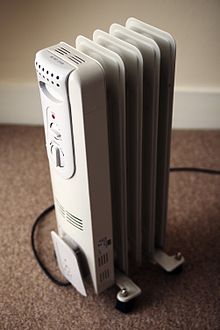- Oil heater
-
An oil heater, also often known as a column heater, is a common form of convection heater used in domestic heating. Although filled with oil, it is electrically heated and does not involve burning any oil fuel, such as kerosene.
Contents
How it works
Oil heaters consist of metal columns with hollow cavities, inside which oil flows freely around the heater. A heating element at the base of the heater heats up the oil, which then flows around the cavities of the heater by convection. The oil acts as a heat reservoir or buffer, with a relatively high specific heat capacity (approximately 2 kJ.kg-1.K-1)[1] and high boiling point (approximately 150-300 degrees Celsius)[2][3]. The high specific heat capacity allows the oil to store a large amount of thermal energy in a small volume, while the high boiling point allows it to remain in the liquid phase for the purpose of heating, so that the heater does not have to be a high pressure vessel.
Using the oil as a heat reservoir, the heating element heats the oil, which remains warm for a long period of time while the heat is transferred to the metal wall through convection, through the walls via conduction, then to the surroundings via convection and radiation. The columns of oil heaters are typically constructed as thin fins, such that the surface area of the metal columns is large relative to the volume of the oil heat reservoir. A large surface area allows more air to be in contact with the heater at any point in time, allowing for the heat to be transferred more rapidly from the heater into the room.
Efficiency
Although oil heaters are more expensive to run and provide far less spatial heating than gas heaters, they are still commonly used in bedrooms and other small-to-medium-sized enclosed areas. This is because gas heaters, especially when unflued, are not suitable for bedroom use - gas heaters cannot be used in confined spaces due to the reduced oxygen and emissions produced. This leaves electrically powered heaters, such as oil heaters and fan heaters, as the only alternative.
There are several efficiencies that can be measured in regards to heaters: the efficiency of the heater at converting electricity to heat, the efficiency of heating a room with a given amount of power may also be measured. The efficiency of the electrical generator which powers the heater and power loss from transporting the electricity over power lines may be measured also. Measures may also consider how well a heater keeps the temperature of a space above a certain point. Such a measure would find inefficiencies in heating an already warm room. Many heaters (the majority of currently available models) are equipped with a thermostat to prevent this inefficient heating, which in turn reduces running costs compared to heaters without a thermostat. This feature was much more common in oil heaters than in the cheaper fan heaters until recently; thus many older oil heaters will be cheaper and more efficient to run than their contemporary fan heaters that lack the thermostat.
Typical oil heaters range in power consumption/output from 300 to 2400 Watts, and their length and number of columns is roughly proportional to their power rating. A 2400 Watt oil heater is usually approximately 1 metre (3.3 feet) in length.
Safety and features
In general, oil heaters are considered safer than electric fan heaters, as they can have lower surface temperatures and require less consideration of the flow of air through/over the heater.
Most modern small heaters have some form of tilt sensor to cut power if they are knocked over or placed on an unstable surface. This can reduce the risk of fire if a heater is knocked over.
The surface temperature of oil heaters is usually low enough to be able to dry items of clothing by hanging them over the heater. Great caution must be exercised as there is a fire risk if the clothing is not removed immediately once it is dry; especially in the case of synthetic fabrics such as polyester, which can be melted or burnt where they are in contact with the heater. It should also be noted that some oil heaters contain strong warnings to avoid operation in damp areas (such as bathrooms or laundry rooms) because the moisture and humidity can damage components of the heater itself. From a safety standpoint, having any objects within three feet of an oil heater is generally to be avoided, and using one to dry clothes is not recommended by any modern manufacturer.
Even though, in normal operation, the surface temperature of the heater is quite low, the extra thermal resistance of the clothing on the heater can cause its surface temperature to rise in order to maintain the same level of heating for the room.
Some companies offer oil heaters with a fan to encourage air flow over the heater. Since it is constantly bringing the colder air from the room into contact with the heater, this can improve the rate of heat flow from the heater into the room. The rate of heat flow from the heater into the air in contact with it is higher when there is a greater temperature difference between said heater and air.
References
Categories:- Heaters
- Home appliances
Wikimedia Foundation. 2010.

